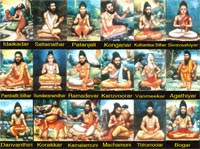First step in this procedure is to remove the poisonous property in paashaanam through purification process. This is the time taking as well as tedious job to handle and cannot be over anxious. To get the desired result, it is necessary to follow the popular proverb, ‘patience is a virtue’. So, it finally took two whole months to complete the entire purification process.
The clear explanation of purification process is obtained from “Uroma Rishi Maruththuva Vaakadam”, written by Roma rishi and I adopted his procedure in my practical realization.
"ஆமப்பா இன்னமொரு கருவைக் கேளு
aamappaa innamoru karuvaik kaelu
ஆதியென்ற பாசாணஞ் சுத்தி சொல்வேன்
aathiyenra pasaananj suththi solvaen
சாமப்பால் ஒருகலசந் தன்னில் வாங்கி
saamappaal orukalasan thannil vaangi
கருவான பூரணமும் பூரஞ் செர்த்து
karuvaana pooranmum pooranj serththu
தாமப்பா குருவதனைக் கரைத்து நல்ல
thaamappaa kuruvathanaik karaithu nalla
தருவான பாசாணந் தன்னை வாங்கி
tharuvaana paasaanan thannai vaangi
போமப்பா தோலாந்திர மாகக் கட்டிப்
poamappaa thoalaanthira maakak kattip
பூரணமாஞ் சலந்தனிலே தூக்கி டாயே
pooranamaanj salanththanilae thookki daayae
தூக்கிடுவாய் நீர்வற்ற எரித்து நல்ல
thookkiduvaai neervatra eriththu nalla
சுத்தமுள்ள பாசாணஞ் சுத்தியாமே
suththamulla paasaanj suththiyaamae”
- மருத்துவ வாகடம் (Maruththuva vaakadam)
Let us see the purification process of each paashaanam.
The apirakap paashaanam is placed in lemon according to its quantity. Then, if we do pudam, we will get the purified paashanam.. Hence, for this purification process considerable amount of lemon is required according to the need.
For kar baashaanam purification, equal amount of neem seed milk and milk of yarcum is mixed with kar paashanam and condensed. Care should be taken regarding the accuracy of milk proportion in this process.
Now the soothap paashaanam is immersed in milk of white yarcum for a day followed by immersing it in lemon juice for a day. Now it is washed with vinegar and dried. Then, drill the root of merukkan, inserting the paashaanm in it and close with its own root. Now make the layer of cow dung over that root and do pudam. Then it is cooled to get the purified paashaanam which is one of the time consuming job also, requires lot of patience.
First cover the thuththap paashanam in cloth and make small hole in lime stone and insert the thuththa paashaanm in it. Cover the entire hole using lemon stone itself. Now boil the above with palmyra toddy for 1 saamam* using 2 type of twigs for burning. Finally we get the purified thuththap paashaanam. Accurate timing and medium fire should be noted during this process.
On one earthen vessel, vinegar, lemon juice and extract of hibiscus cannabinus is added in equal amount. Along with this, the seelai paashaanam is tied in silk cloth and allowed to condense in medium fire to get the purified paashaanam.
It almost takes complete 2 months for finishing the entire purification process. Next step is making kuzhambu* from the above and allowed to set in mold to achieve the desired paashaanak kattu.
As I have no idea of uploading or sharing this information here in internet while doing this purification process, I did not take any pictures. However, in the next post I will definitely show you the picture of Pancha paashana lingam, a successful outcome of my first practical research work
Stay tuned!!
*Saamam – 3 hours especially at midnight
*Kuzhambu – the liquid of thick consistency (such as sandal paste)
Original – www.siththarkal.com
Translated by Lalithambika Rajasekaran

